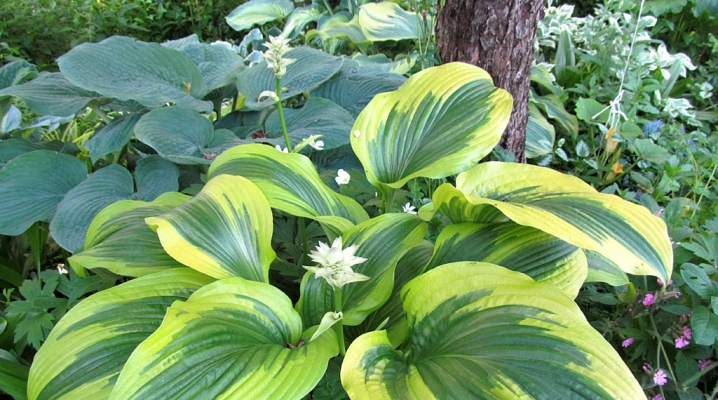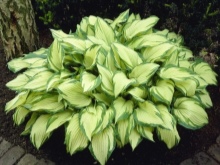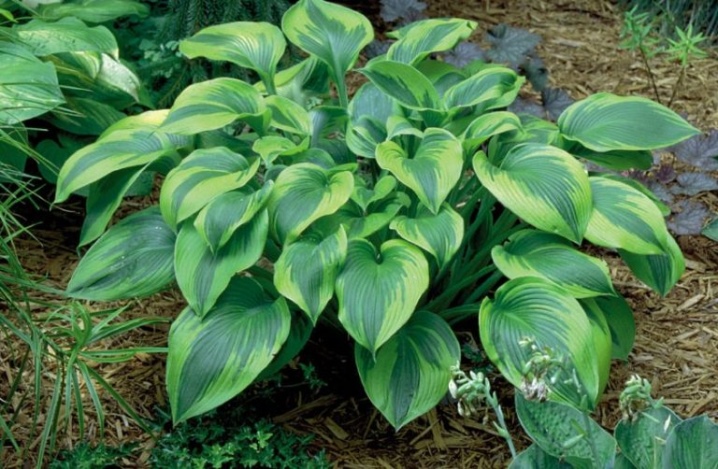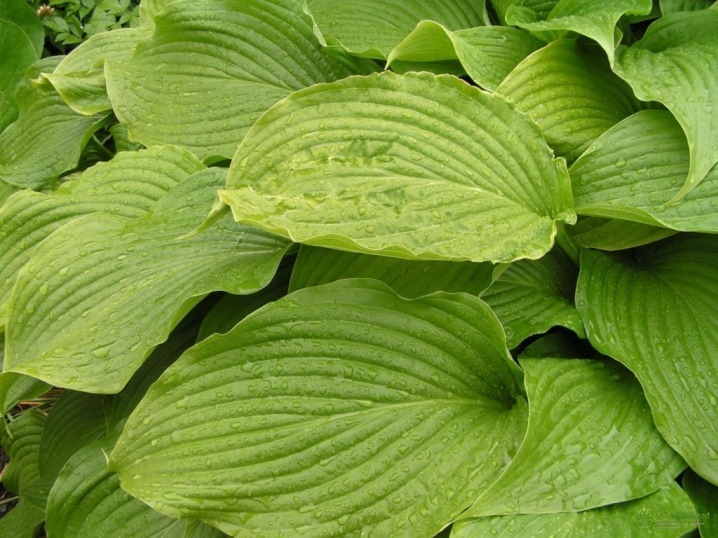Hosta fortune: description and forms, care tips

Hosta belongs to those crops that are able to harmoniously combine plants in the garden, giving the compositions a finished form. Hosta fortune, with its huge leaf plates, makes a very beautiful addition to the garden.


Description
This incredible plant is native to Japan. The bush is compact, but at the same time powerful in size. Fortune belongs to perennials and has wide leaf plates that have a heart-shaped or oval shape. They grow up to 12 cm in length and up to 9 cm in width, forming strong, compact rosettes. The color of the leaves is green with a light blue bloom, along the edges there is a golden or white edging.


The bush has a height of 50-60 cm. On long, half-meter peduncles, violet, elongated, rather large buds (about 6 cm in diameter) are formed, the flowering of which falls at the end of summer. The shape of the flowers is funnel-shaped, they gather in racemose, multi-flowered inflorescences. The root system is unbranched, well developed. The plant is shade-loving, but some of its hybrids feel quite normal in well-lit areas.


Hosta fortune can grow in the same place for over 20 years.
Varieties and varieties
Hosta fortunei has several cultural forms.
- Fortunei Albopicta it differs in different color of foliage: at first it is yellowish-cream with intermittent green edging, and then it acquires an olive-green color. The inflorescences have a lavender shade, prefers partial shade for cultivation.
- Fortunei Aureomarginata it stands out with large leafy plates of green color with a slight bluish tint, golden or yellow-bordered, at the end of the season "Aureomarginata" becomes creamy, blooms in a light lavender tone.
- Fortunei Albomarginata has large dark green leaves with a white border around the edge, flowers are characterized by a light lavender color.



Hosta fortune has a fairly large number of varieties.
- Aurea blooms with lush purple inflorescences. Leaves are cordate, firm to the touch, with distinct veins. The color of the leaf plates is first golden yellow, then it acquires a delicate lemon-yellow hue. The shape of the bush is quite lush, it reaches a height of up to 60 cm.

- Aureamaculata grows up to 60 cm. Young leaves have a green edging and a yellowish center, in the middle of the season they become duller, and at the end of summer they acquire a uniform green color.

- Ferising - a bush with large, wide leaves of a dark green color and white inflorescences.

- Hyacinthina - a hyacinth variety hosta, forms beautiful inflorescences of a dark purple tone, late flowering. "Hyacinthine" is not very high, about 50 cm in height, compact in size. The leaf plates are gray-blue, matte.
This variety does not set seeds.

- Gold Standart characterized by rapid growth. The leaves are golden with a narrow edging of green. Hosta "Gold Standard" is a rather tall plant, it can grow up to 70 cm.

- Marginato albo - a large, sprawling bush with a peduncle height of 70 cm. The leaves are large, rather wide, have a voluminous white border.

- Rugosa has rather significant leaf plates with strongly pronounced veins. The flower stalk can reach 65 cm, light purple buds are formed on it, which gather in a wide, short inflorescence.

- Stenantha differs in wrinkled gray leaves, which eventually turn green. The bush is not very large. The inflorescence petals are straight, purple-pink, collected in narrow tubular flowers.

- Obscura - not very tall plant, 50-60 cm in height. The leaves of the Obscura variety are matte, green, and have very noticeable veins.
Characterized by resistance to sunlight.

- Francee possesses heart-shaped dark green leaf plates with pronounced venation. They have a white border around the edges. "Francie" blooms with delicate lavender flowers.

Growing features
Hosta fortune is characterized by rather rapid growth and low maintenance requirements. The soil for planting a plant needs slightly acidic and with good moisture permeability. A mixture of equal parts of peat, leaf humus, river sand and crushed sphagnum is optimal. The site should be chosen shaded or with partial shade. A little water is poured into the dug holes, mineral fertilizers are added, then the seedling is placed in the hole, carefully spreading the roots, and covered with earth.
From above, the soil is tamped and watered, you can also spread a layer of mulch around the plant. Hosta care consists in:
- regular watering (morning or evening);
- systematic feeding 2-4 times per season;
- loosening the soil and removing weeds;
- cutting off peduncles after flowering;
- pruning for the winter.

It is not necessary to cover adult plants for the winter period, they tolerate frosts normally, but young bushes can be covered with agrofibre. Bred to host:
- seeds;
- cuttings;
- dividing the bush.
The seed method is used mainly by breeders to develop new varieties. For him, seeds are sown for seedlings, they create greenhouse conditions for them, and after the appearance of leaves they dive. It is worth planting seedlings in the soil when they have at least 4 buds.
For cuttings, small rosettes with leaves are carefully separated from the bush without digging it out. They are planted in the soil, watered regularly, and make complex dressings. When the plant gets stronger, it is planted in the chosen place.
When multiplying by dividing, the bush is carefully dug out, divided into several parts with a sharp knife, each should have several buds. They are planted in the same way as when grafting.
Hosta fortune looks spectacular in any landing and, with proper care, will serve as a decoration of the site for many years.
An overview of the host plant fortune France in the video below.







































































































The comment was sent successfully.